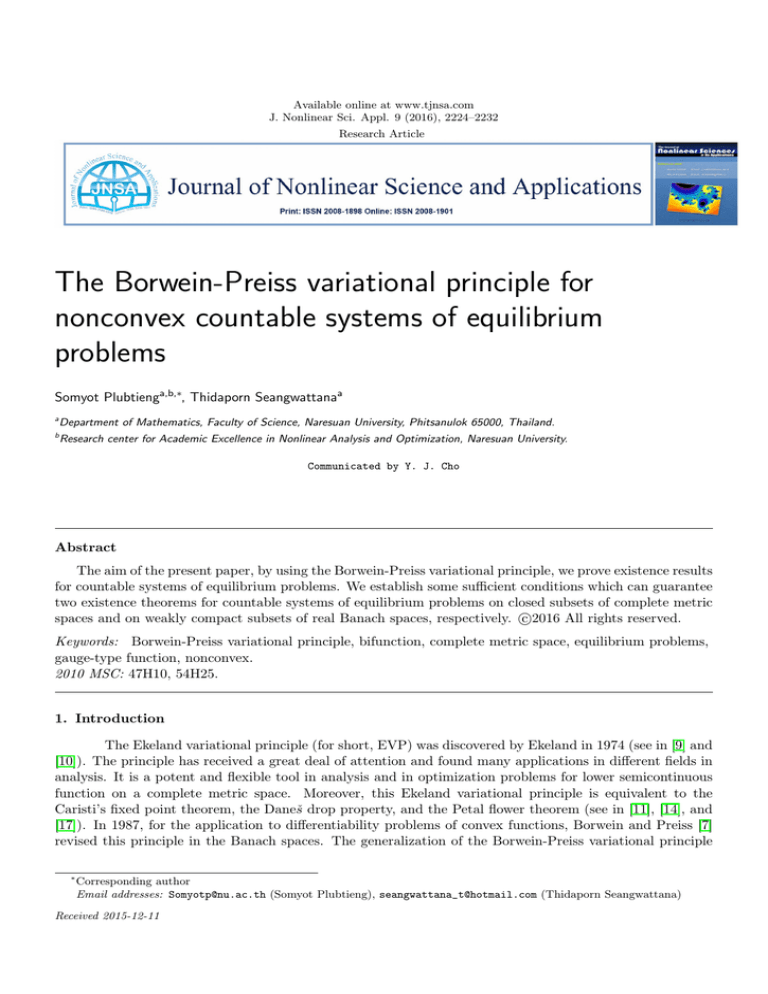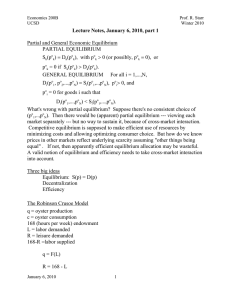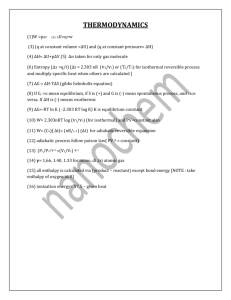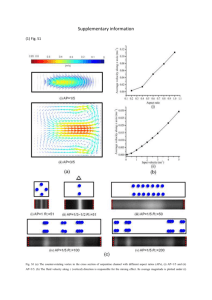
Available online at www.tjnsa.com
J. Nonlinear Sci. Appl. 9 (2016), 2224–2232
Research Article
The Borwein-Preiss variational principle for
nonconvex countable systems of equilibrium
problems
Somyot Plubtienga,b,∗, Thidaporn Seangwattanaa
a
Department of Mathematics, Faculty of Science, Naresuan University, Phitsanulok 65000, Thailand.
b
Research center for Academic Excellence in Nonlinear Analysis and Optimization, Naresuan University.
Communicated by Y. J. Cho
Abstract
The aim of the present paper, by using the Borwein-Preiss variational principle, we prove existence results
for countable systems of equilibrium problems. We establish some sufficient conditions which can guarantee
two existence theorems for countable systems of equilibrium problems on closed subsets of complete metric
c
spaces and on weakly compact subsets of real Banach spaces, respectively. 2016
All rights reserved.
Keywords: Borwein-Preiss variational principle, bifunction, complete metric space, equilibrium problems,
gauge-type function, nonconvex.
2010 MSC: 47H10, 54H25.
1. Introduction
The Ekeland variational principle (for short, EVP) was discovered by Ekeland in 1974 (see in [9] and
[10]). The principle has received a great deal of attention and found many applications in different fields in
analysis. It is a potent and flexible tool in analysis and in optimization problems for lower semicontinuous
function on a complete metric space. Moreover, this Ekeland variational principle is equivalent to the
Caristi’s fixed point theorem, the Daneš drop property, and the Petal flower theorem (see in [11], [14], and
[17]). In 1987, for the application to differentiability problems of convex functions, Borwein and Preiss [7]
revised this principle in the Banach spaces. The generalization of the Borwein-Preiss variational principle
∗
Corresponding author
Email addresses: Somyotp@nu.ac.th (Somyot Plubtieng), seangwattana_t@hotmail.com (Thidaporn Seangwattana)
Received 2015-12-11
S. Plubtieng, T. Seangwattana, J. Nonlinear Sci. Appl. 9 (2016), 2224–2232
2225
on a complete metric space appeared in 2005 (see in [8]).
One of the most important problems in nonlinear analysis is the so-called equilibrium problem considered
by Takahashi [19] (see also in [6]). Let A be a nonempty set and φ : A × A → R a bifunction. The problem
consists of finding an element a∗ ∈ A such that
φ(a∗ , a) ≥ 0,
∀ a ∈ A.
(EP)
Furthermore, equilibrium problems have been extensively studied (e.g. [5], [12], [15] and the references
therein). The reason of studies of equilibrium problems is that it was applied among its particular cases,
variational inequalities (monotone or otherwise), Nash equilibrium problems, optimization problems, and
saddlepoint (minimax) problems (see [12] for a survey). Recently, Ansari, Schaible, and Yao [3] introduced
a system of equilibrium problems and established existence results of the problems (see also in [13], [16] and
[18]).
In 2005, Bianchi, Kassay and Pini [5] studied existence results of equilibrium problems and a system of
equilibrium problems via the Ekeland variational principle (see also in [2] and [4]). Very recently, Alleche and
Rǎdulescu [1] studied the Ekeland variational principle for equilibrium problems and a system of equilibrium
problems under real Banach spaces. They also proved a result to guarantee for an existence of solutions for
countable systems of equilibrium problems in the non weakly compact case which is a generalization of ([2],
Theorem 15).
In this paper, by using the Borwein-Preiss variational principle, we prove existence results for countable
systems of equilibrium problems. We establish some sufficient conditions which can guarantee for existence
theorems of countable systems of equilibrium problems on closed subsets of complete metric spaces and on
weakly compact subsets of real Banach spaces, respectively.
2. Preliminaries
The purpose of this section, we will introduce the significant definitions, theorems and corollary for
using in the following section.
Definition 2.1 ([8]). Let (X, d) be a metric space. We say that a continuous function ρ : X × X → [0, ∞]
is a gauge-type function on a complete metric space (X, d) provided that
(i) ρ(x, x) = 0 for all x ∈ X,
(ii) for any > 0 there exists δ > 0 such that for all y, z ∈ X we have ρ(y, z) ≤ δ implies that d(y, z) < .
The following theorem, it is well-known that the Borwein-Preiss variational principle on a complete
metric space.
Theorem 2.2 ([8]). Let (X, d) be a complete metric space and let f : X → R ∪ {+∞} be a lower semicontinuous function bounded from below. Suppose that ρ is a gauge-type function and {δi }∞
i=0 is a sequence of
positive numbers, and suppose that > 0 and z ∈ X satisfy
f (z) ≤ inf f (x) + .
x∈X
Then, there exist y and a sequence {xi } ⊂ X such that
(ā.) ρ(z, y) ≤ δ0 , ρ(xi , y) ≤ 2iδ0 ,
P
(b̄.) f (y) + ∞
i=0 δi ρ(y, xi ) ≤ f (z), and
P
P∞
(c̄.) f (x) + ∞
i=0 δi ρ(x, xi ) > f (y) +
i=0 δi ρ(y, xi ), for all x ∈ X \ {y}.
S. Plubtieng, T. Seangwattana, J. Nonlinear Sci. Appl. 9 (2016), 2224–2232
2226
Corollary 2.3. Let (X, d) be a complete metric space and let f : X → R ∪ {+∞} be a lower semicontinuous
function bounded from below. Suppose that ρ is a gauge-type function and {δi }∞
i=0 is a sequence of positive
numbers. Then for any > 0, there exist y and a sequence {xi } ⊂ X satisfying the following two conditions:
P
(1) f (y) + ∞
i=0 δi ρ(y, xi ) ≤ inf x∈X f (x) + ;
P∞
P
(2) f (w) + i=0 δi ρ(w, xi ) ≥ f (y) + ∞
i=0 δi ρ(y, xi ) for all w ∈ X.
Proof. It is obvious from Theorem 2.2.
Definition 2.4 ([1]). The function f is said to be sequentially upper (resp. sequentially lower) semicontinuous on a subset A of X if it is sequentially upper (resp. sequentially lower) semicontinuous at every point
of A.
Definition 2.5 ([1]). Let X be a Banach space (more generally it may be a Hausdorff topological space),
x ∈ X and f : X → R a function. the function f is said to be
(1) sequentially upper semicontinuous at x if for every sequence {xn }n → x ∈ X,
we have
f (x) ≥ lim sup f (xn ),
n→+∞
where lim supn→+∞ f (xn ) = inf n supk≥n f (xk );
(2) sequentially lower semicontinuous at x if −f is sequentially upper semicontinuous at x.
Hausdorff topological space is called sequentially compact if every sequence has a converging subsequence.
A subset A of a Hausdorff topological space is called sequentially compact if it is sequentially compact as a
topological subspace.
3. Main theorem
Let I be a countable index set. Assume that Ai is a closed subset of a complete metric space (Xi , di )
and ρi is a gauge-type function on (Xi , di ), for every i ∈ I. The system of equilibrium problems is a problem
of finding x∗ = {x∗i }i∈I such that
φi (x∗ , yi ) ≥ 0, ∀ i ∈ I and yi ∈ Ai ,
(SEP)
Q
where φi : A × Ai → R, A = i∈I Ai with Ai some given sets. Without loss ofQgenerality, we may assume
that di and ρi are bounded by 1 for all i ∈ I. An element of the set Ai = j∈I Aj with j 6= i will be
Q
represented by xi . Therefore, x̄ ∈ A can be written as x̄ = (xi , xi ) ∈ Ai × Ai . The space X = i∈I Xi will
be endowed by the product topology. The distance d and gauge-type function ρ on X defined by
d(x, y) =
X 1
di (xi , yi ) , ∀ x = {xi }i∈I , y = {yi }i∈I ∈ X,
2i
i∈I
and
ρ(x, y) =
X 1
ρi (xi , yi ) , ∀ x = {xi }i∈I , y = {yi }i∈I ∈ X
2i
i∈I
respectively. Therefore, the space (X, d) is a complete metric space.
The following theorem is the Borwein-Preiss variational principle for nonconvex countable systems of
equilibrium problems defined on complete metric spaces.
S. Plubtieng, T. Seangwattana, J. Nonlinear Sci. Appl. 9 (2016), 2224–2232
2227
Theorem 3.1. Let Ai be a nonempty closed subset of a complete metric space (Xi , di ) and φi : A × Ai → R,
for every i ∈ I. Assume that, for every i ∈ I, the following conditions hold:
(1) φi (ā, ai ) = 0, for every ā = (ai , ai ) ∈ A;
(2) φi (ā, bi ) ≤ φi (ā, ci ) + φi (c̄, bi ) for every bi , ci ∈ Ai , and ā, c̄ ∈ A such that c̄ = (ci , ci );
(3) φi is lower bounded and lower semicontinuous in its second variable.
Suppose that {δ n }∞
n=0 is a sequence of positive numbers and ρi is a gauge-type function and suppose that
> 0 and z̄ = {zi }i∈I ∈ A, there exists mi ∈ Ai with
φi (z̄, mi ) ≤ inf φi (z̄, xi ) + ,
xi ∈Ai
for all i ∈ I. Then, for every z̄ = {zi }i∈I ∈ A, there exist ȳ = {yi }i∈I ∈ A and a sequence {x̄n }∞
n=0 =
{(xni )i∈I }∞
∈
A
such
that,
for
all
i
∈
I,
n=0
(i) φi (z̄, yi ) +
P∞
(ii) φi (ȳ, xi ) +
P∞
n=0 δ
n=0
n ρ (y , x̄ )
i i n
δ n (ρ
≤ 0;
i (xi , x̄n )
− ρi (yi , x̄n )) > 0, ∀xi ∈ Ai and xi 6= yi .
Proof. We define sequences {xni } and Fin for all i ∈ I inductively. Let x0 := z̄ ∈ A and for all i ∈ I
Fi0 := {xi ∈ Ai |φi (x0 , xi ) + δ 0 ρi (xi , x0i ) ≤ 0}.
(3.1)
From the condition (1), we obtain that x0i ∈ Fi0 . Hence, by the condition (3), Fi0 is nonempty and closed
set. For all i ∈ I and xi ∈ Fi0 , we note that
δ 0 ρi (xi , x0i ) ≤ −φi (x0 , xi ) ≤ φi (x0 , x0i ) − φi (x0 , xi )
≤ φi (x0 , x0i ) − inf φi (x0 , xi ) ≤ .
xi ∈Ai
For all i ∈ I, we choose x1i ∈ Fi0 such that
φi (x
0
, x1i )
+δ
0
ρi (x1i , x0i )
≤ inf
xi ∈Fi0
≤ φi (x
and hence
δ
0
ρi (x1i , x0i )
0
0
φi (x , xi ) + δ
, x1i )
0
ρi (xi , x0i )
+ inf
xi ∈Fi0
1
+
φi (x , xi ) + δ
0
δ1
2δ 0
ρi (xi , x0i )
δ1
1
0
0
≤ inf φi (x , xi ) + δ ρi (xi , xi ) + 0 .
2δ
xi ∈Fi0
For any fixed i ∈ I, we define
Fi1
:=
xi ∈
Fi0 |φi (x1 , xi )
+
1
X
δ
k
ρi (xi , xki )
≤δ
0
ρi (x1i , x0i )
.
k=0
Similarly, for all i ∈ I, we take x2i ∈ Fi1 such that
1
X
k=0
and define
1
X
δ2
φi (x2 , xi ) +
δ k ρi (xi , xki ) + 0
2δ
xi ∈Fi1
δ k ρi (x2i , xki ) ≤ inf
k=0
+
δ1
,
2δ 0
S. Plubtieng, T. Seangwattana, J. Nonlinear Sci. Appl. 9 (2016), 2224–2232
Fi2
xi ∈
:=
Fi1 |φi (x2 , xi )
2
X
+
δ
k
ρi (xi , xki )
1
X
≤
k=0
δ
k
2228
ρi (x2i , xki )
.
k=0
In general, for all i ∈ I and for j = 0, 1, . . . , n − 1, suppose that we have defined xji , Fij satisfying
j−1
X
δ
k
ρi (xji , xki )
≤
k=0
inf
Fij
xi ∈
:=
φi (x , xi ) +
xi ∈Fij−1
and
Fij−1 |φi (xj , xi )
+
j−1
X
j
δ
k
ρi (xi , xki )
+
k=0
j
X
δ
k
ρi (xi , xki )
j−1
X
≤
k=0
δ
k
ρi (xji , xki )
δj 2δ 0
, ∀ i ∈ I.
k=0
For all i ∈ I, we choose xni ∈ Fin−1 such that
n−1
X
δ
k
ρi (xni , xki )
≤
k=0
inf
xi ∈Fin−1
φi (x , xi ) +
:=
xi ∈
Fin−1 |φi (xn , xi )
n−1
X
δ
k
ρi (xi , xki )
+
k=0
and define
Fin
n
+
n
X
δ
k
ρi (xi , xki )
≤
k=0
n−1
X
δ
k
δn
2δ 0
(3.2)
ρi (xni , xki )
.
(3.3)
k=0
Thus, we see that, for every n = 1, 2, . . . , Fin is nonempty and closed set. It follows from (3.2) and (3.3)
that, for all i ∈ I, n = 1, 2, . . . , and xi ∈ Fin
δ
n
ρi (xi , xni )
≤
≤
≤
n−1
X
k=0
n−1
X
k=0
δn
2δ 0
δ
k
ρi (xni , xki )
n−1
X
n
− (φi (x , xi ) +
δ k ρi (xi , xki ))
k=0
δ
k
ρi (xni , xki )
−
inf
xi ∈Fin−1
n
φi (x , xi ) +
n−1
X
δ
k
ρi (xi , xki )
k=0
.
Thus, we see that there exists δ := 2δ 0 such that ρi (xi , xni ) ≤ δ for all i ∈ I, n = 1, 2, . . . , and xi ∈ Fin . Since
ρi is a gauge-type function, it follows that di (xi , xni ) → 0 as n → ∞ uniformly. Hence diam(Fin ) → 0 and
n
therefore, by Cantor’s intersection theorem, there exists a unique yi ∈ ∩∞
n=0 Fi for all i ∈ I. This implies
n
that xni → yi as n → ∞. For any i ∈ I, if xi 6= yi , we can conclude that xi 6∈ ∩∞
n=0 Fi . Therefore for some j,
j
X
δk ρi (xi , xki )
>
k=0
j−1
X
δk ρi (xji , xki ) − φi (xj , xi ).
(3.4)
k=0
This implies that
j
φi (x , xi ) +
∞
X
δk ρi (xi , xki )
j
≥ φi (x , xi ) +
k=0
> φi (xj , xi ) +
j
X
k=0
j−1
X
δk ρi (xi , xki )
δk ρi (xji , xki ) − φi (xj , xi )
k=0
=
j−1
X
k=0
δk ρi (xji , xki ).
(3.5)
S. Plubtieng, T. Seangwattana, J. Nonlinear Sci. Appl. 9 (2016), 2224–2232
2229
n
On the other hand, it follows from (3.1), (3.3), and yi ∈ ∩∞
n=0 Fi that, for all q ≥ j,
−φi (x0 , xji ) ≥
j−1
X
δk ρi (xji , xki )
k=0
≥
q−1
X
δk ρi (xqi , xki ) + φi (xj , xqi )
k=0
≥ φi (xj , xqi ) + φi (xq , yi ) +
q
X
(3.6)
δk ρi (yi , xki )
k=0
≥ φi (xj , yi ) +
q
X
δk ρi (yi , xki ).
k=0
From (3.6), we obtain that, for any q ≥ j and i ∈ I,
0
0 ≥ φi (x , yi ) +
q
X
δk ρi (yi , xki ).
(3.7)
k=0
Combining (3.5) and (3.6) yields for any q ≥ j and i ∈ I,
j
j
φi (x , xi ) − φi (x , yi ) +
∞
X
δk ρi (xi , xki )
k=0
>
q
X
δk ρi (yi , xki ).
k=0
Since φi (xj , xi ) − φi (xj , yi ) ≤ φi (ȳ, xi ), we have
φi (ȳ, xi ) +
∞
X
δk ρi (xi , xki )
>
q
X
δk ρi (yi , xki ).
(3.8)
k=0
k=0
By taking limits in (3.7) and (3.8) as q → ∞, we have
0 ≥ φi (z̄, yi ) +
∞
X
δk ρi (yi , xki )
k=0
and
φi (ȳ, xi ) +
∞
X
k=0
δk ρi (xi , xki ) >
∞
X
δk ρi (yi , xki )
k=0
for all i ∈ I. This completes the proof.
Example 3.2. Let Ai be a nonempty closed
Q subset of a usual metric space (R, d) with the gauge-type
function ρi = d, for every i ∈ I, and A = i∈I Ai . Suppose that φi : A × Ai → R is a real valued function
defined by
1
1
φi (ā, bi ) =
− , ∀ ā = {ai }i∈I ∈ A, bi ∈ Ai .
ai bi
It is easy to see that both functions (ρi and φi ) satisfy the conditions in Theorem 3.1. Suppose that {δ n }∞
n=0
is a sequence of positive numbers and suppose that > 0 and z̄ = {zi }i∈I ∈ A. Then, by Theorem 3.1, there
zi
1
n
∞
n
i
exist ȳ = {yi }i∈I with yi = ziz+1
∈ Ai and a sequence {xn }∞
n=0 = {(xi )i∈I }n=0 with xi = zi +1 + δ n 2kn ∈ Ai ,
where {kn } is a subsequence of a sequence of natural numbers, such that
S. Plubtieng, T. Seangwattana, J. Nonlinear Sci. Appl. 9 (2016), 2224–2232
φi (z̄, yi ) +
∞
X
2230
∞
δ n ρi (yi , x̄n ) =
n=0
1 X n
1
− +
δ ρi (yi , xni )
zi yi
n=0
≤
zi + 1
1
−
+1=0
zi
zi
for all i ∈ I. Furthermore, for every xi 6= yi , we have
φi (ȳ, xi ) +
∞
X
n
δ ρi (xi , x̄n ) −
n=0
∞
X
n=0
∞
X
1
1
δ ρi (yi , x̄n ) ≥
−
+
δ n ρi (xi , xni ) − 1 > 0.
yi xi
n
n=0
Putting I = {1}, X1 = X and A1 = A in Theorem 3.1, we have the following result.
Corollary 3.3. Let A be a nonempty closed subset of a complete metric space (X, d) and φ : A × A → R be
a bifunction. Assume that the following conditions hold:
(1) φ(a, a) = 0, for every a ∈ A;
(2) φ(a, b) ≤ φ(a, c) + φ(c, b) for every a, b, c ∈ A;
(3) φ is lower bounded and lower semicontinuous in its second variable.
Suppose that {δ n }∞
n=0 is a sequence of positive numbers and ρ is a gauge-type function and suppose that
> 0 and z ∈ A. There exists m ∈ A with
φ(z, m) ≤ inf φ(z, x) + .
x∈A
There exist y and a sequence {xn }∞
n=0 ⊂ A such that
(i) φ(z, y) +
P∞
(ii) φ(y, x) +
P∞
n=0 δ
n ρ(y, x )
n
≤ 0;
n
n=0 δ (ρ(x, xn )
− ρ(y, xn )) > 0, ∀x ∈ A and x 6= y.
In the final of this section, we will prove existence theorems for solutions of countable systems of equilibrium problems in the weakly compact case and non weakly compact case, respectively. Here, the space
Xi is replaced by a real Banach space Ei , for every i ∈ I (Denoted by k · ki ).
The following proposition can guarantee the existence of solutions to countable systems of equilibrium
problems in the weakly compact case.
Proposition 3.4. Let Ai be a nonempty weakly closed subset of a real Banach space Ei and φi : A×Ai → R,
for every i ∈ I. Assume that the following conditions hold:
(1) φi (ā, ai ) = 0, for every i ∈ I and ā = (ai , ai ) ∈ A;
(2) φi (ā, bi ) ≤ φi (ā, ci ) + φi (c̄, bi ) for every i ∈ I, bi , ci ∈ Ai , and ā, c̄ ∈ A such that c̄ = (ci , ci );
(3) φi is lower bounded and lower semicontinuous in its second variable, for every i ∈ I.
(4) φi is weakly sequentially upper semicontinuous in its first variable, for every i ∈ I.
Q
(5) A is sequentially compact subset of E = i∈I Ei with respect to the topology σ.
Then, the system of equilibrium problems (SEP) has a solution.
Proof. For every n ∈ N, we choose a sequence {z̄n } = {(zin )i∈I } ⊆ A and n = n1 . By Theorem 3.1, there
exists {x̄n } = {(xni )i∈I } ⊆ A which is a solution of the system of equilibrium problems (SEP) such that
1
φi (x̄n , yi ) ≥ − kzin − yi ki , ∀ yi ∈ Ai .
n
S. Plubtieng, T. Seangwattana, J. Nonlinear Sci. Appl. 9 (2016), 2224–2232
2231
Since A is a sequentially compact subset of E with respect to the topology σ, the sequence {x̄n }n has a
converging subsequence {x̄nk }k to some x̄ = {x̄i }i∈I ∈ A with respect to the topology σ. By the sequentially
upper semicontinuity of a function φi , we see that, for every i ∈ I,
φi (x̄, yi ) ≥ lim sup φi (x̄ni k , yi )
k→∞
1
≥ lim sup − kzink − yi ki ) = 0 , ∀yi ∈ Ai .
k→∞
nk
Therefore x̄ is a solution to the system of equilibrium problems (SEP).
The ensuing theorem can guarantee the existence of solutions to countable systems of equilibrium problems in the non weakly compact case.
Theorem 3.5. Let Ai be a nonempty weakly closed subset of a real reflexive Banach space Ei and
φi : A × Ai → R, for every i ∈ I. Assume that the following conditions hold:
(1) φi (ā, ai ) = 0, for every i ∈ I and ā = (ai , ai ) ∈ A;
(2) φi (ā, bi ) ≤ φi (ā, ci ) + φi (c̄, bi ) for every i ∈ I, bi , ci ∈ Ai , and ā, c̄ ∈ A such that c̄ = (ci , ci );
(3) there exists a nonempty closed subset Ki of Ai for every i ∈ I such that for every x̄ = (xi , xj ) ∈ A
with xj 6∈ Kj for some j ∈ I,
∃yj ∈ Aj , kyj k < kxj k, φj (x, yj ) ≤ 0;
(4) φi is sequentially lower semicontinuous in its second variable on Ki for every i ∈ I;
Q
(5) the restriction of φi on ( i∈I Ki ) × Ki is lower bounded in its second variable for every i ∈ I;
Q
(6) the restriction of φi on ( i∈I Ki ) × Ki is weakly sequentially upper semicontinuous in its first
variable, for every i ∈ I;
Q
(7) The subset i∈I Ki is sequentially compact subset of E with respect to the topology σ.
Then, the system of equilibrium problems (SEP) has a solution.
Proof. It follows the proof of Theorem 4.3 in [1].
Putting I = {1}, E1 = E and A1 = A in Theorem 3.5, we have the following result.
Corollary 3.6. Let A be a nonempty weakly closed subset of a real reflexive Banach space E and φ : A×A →
R be a bifunction. Suppose that the following conditions hold:
(1) φ(a, a) = 0, for every a ∈ A;
(2) φ(a, b) ≤ φ(a, c) + φ(c, b), for every x, y, z ∈ A;
(3) there exists a nonempty weakly compact subset K of A such that
∀ x ∈ A \ K, ∃y ∈ A, kyk < kxk, φ(x, y) ≤ 0;
(4) φ is sequentially lower semicontinuous in its second variable on K;
(5) the restriction of φ on K × K is lower bounded in its second variable;
(6) the restriction of φ on K × K is weakly sequentially upper semicontinuous in its first variable.
Then, the equilibrium problem (EP) has a solution.
S. Plubtieng, T. Seangwattana, J. Nonlinear Sci. Appl. 9 (2016), 2224–2232
2232
Acknowledgements
The authors would like to thank Naresuan University and Thailand Research Fund (TRF) for supporting
by permit money of investment under of The Royal Golden Jubillee Ph.D. Program (RGJ-Ph.D.), Thailand.
We thank the anonymous referee for the careful reading of the paper and a valuable suggestion improving
the presentation.
References
[1] B. Alleche, V. D. Rǎdulescu, The Ekeland variational principle for equilibrium problems revisited and applications,
Nonlinear Anal. Real World Appl., 23 (2015), 17–25. 1, 2.4, 2.5, 3
[2] Q. H. Ansari, L. J. Lin, Ekeland-type variational principles and equilibrium problems, in: S. K. Mishra (Ed.),
Topics in Nonconvex Optimization, Springer, Optim. Appl., New York, 50 (2011), 147–174. 1
[3] Q. H. Ansari, S. Schaible, J. C. Yao, System of vector equilibrium problems and its applications, J. Optim. Theory
Appl., 107 (2000), 547–557. 1
[4] M. Bianchi, G. Kassay, R. Pini, Existence of equilibria via Ekelands principle, J. Math. Anal. Appl., 305 (2005),
502–512. 1
[5] M. Bianchi, G. Kassay, R. Pini, Ekeland’s principle for vector equilibrium problems, Nonlinear Anal., 66 (2007),
1454–1464. 1
[6] E. Blum, W. Oettli, From optimization and variational inequalities to equilibrium problems, Math. Student, 63
(1994), 123–145. 1
[7] J. M. Borwein, D. Preiss, A smooth variational principle with applications to subdifferentiability and to differentiability of convex functions, Trans. Amer. Math. Soc., 303 (1987), 517–527. 1
[8] J. M. Borwein, Q. J. Zhu, Techniques of Variational Analysis, Springer, Verlag, New York, (2005). 1, 2.1, 2.2
[9] I. Ekeland, Sur les probléms variationnels, C. R. Acad. Sci. Paris, 275 (1972), 1057–1059. 1
[10] I. Ekeland, On the variational principle, J. Math. Anal. Appl., 47 (1974), 324–353. 1
[11] P. G. Georgiev, The strong Ekeland variational principle, the strong drop theorem and applications, J. Math.
Anal. Appl., 131 (1988), 1–21. 1
[12] G. Kassay, The Equilibrium Problem and Related Topics, Risoprint, Cluj-Napoca, (2000). 1
[13] G. Kassay, On equilibrium problems, Optimization and optimal control, Springer Optim. Appl., New York, 39
(2010), 55–83. 1
[14] J. P. Penot, The drop theorem, the petal theorem and Ekeland’s variational principle, Nonlinear Anal., 10 (1986),
813–822. 1
[15] S. Plubtieng, R. Punpaeng, A general iterative method for Equilibrium problems and fixed point problems in
Hilbert spaces, J. Math. Anal. Appl., 336 (2007), 455–469. 1
[16] S. Plubtieng, T. Thammathiwat, Existence of solutions of systems of generalized implicit vector quasi-equilibrium
problems in G-convex spaces, Comput. Math. Appl., 62 (2011), 124–130. 1
[17] S. Plubtieng, T. Seangwattana, Generalizations of the strong Ekeland varaitional principle with a generalized
distance in complete metric spaces, J. Inequal. Appl., 2013 (2013), 9 pages. 1
[18] S. Plubtieng, K. Sitthithakerngkiet, On the existence result for system of generalized strong vector quasiequilibrium
problems, Fixed Point Theory Appl., 2011 (2011), 9 pages. 1
[19] W. Takahashi, Nonlinear variational inequalities and fixed point theorems, J. Math. Soc. Jpn., 28 (1976), 168–181.
1






